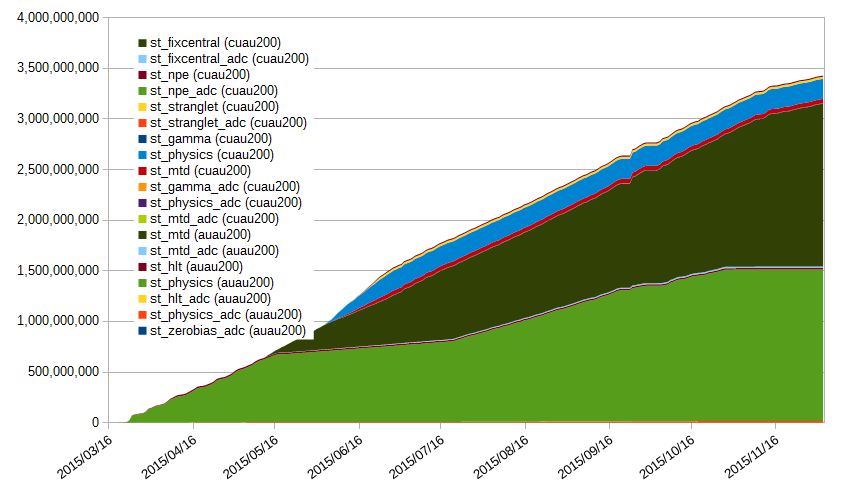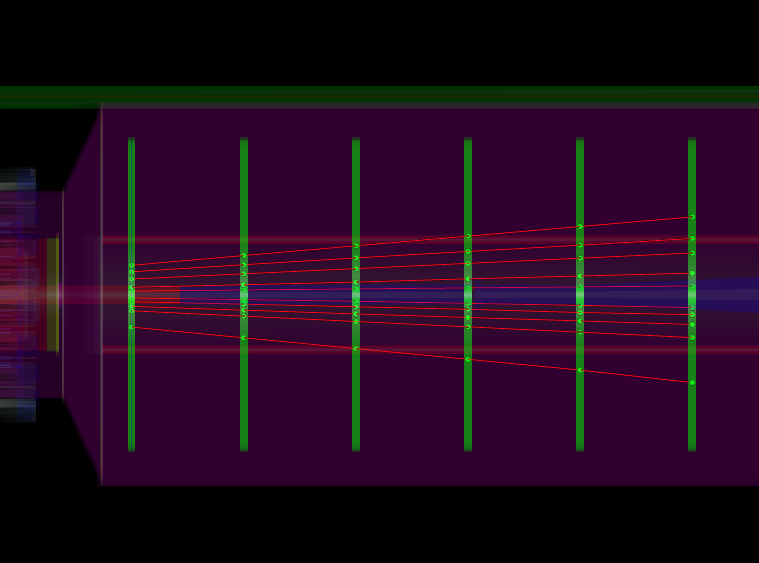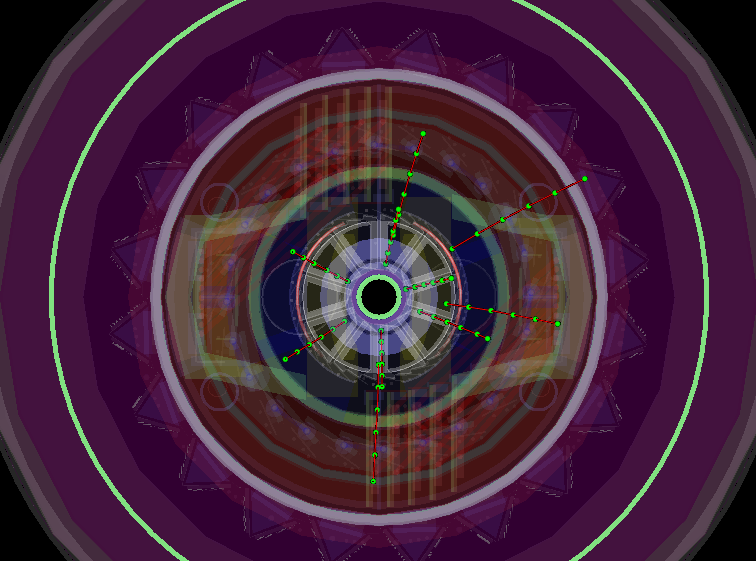STAR Newsletter
Welcome to the STAR Newsletter page.
Please, find the issues on the left hand-side navigation menu or below this page.
If you are a STAR user and would like to discuss items in a dynamic/chat way, you may leave a feedback as comment (your comments will be seen by STAR users only).
For any other users, please send your comments to newseditor [at] www.star.bnl.gov .
If you are looking for older editions of the newsletter, they may be found here.
December 2015
STAR Newsletter
December 2015 edition
Contents:- From the Spokesperson
- Quark Matter 2015
- Operations Activities
- Software & Computing
- Other contribution(s) require authentication to view
A note from the editor: as a collaboration-wide communication tool, this newsletter is set up to allow comments (subject to moderation against abuse), and all STAR Collaborators are welcome to do so! Please keep in mind that some content (including all comments) may be considered internal to the Collaboration and only accessible when logged into Drupal. Documentation is available here.
From the Spokesperson
(Z. Xu - Spokesperson)
Dear STAR Collaborators:
Greetings and welcome to the new edition of the STAR Newsletter!
The STAR management initiates this newsletter edition to provide a forum for timely and organized communications within the entire collaboration on a monthly basis. I would like to thank Gene Van Buren for taking on the task as the main editor.
We will continue most of the columns in the previous Newsletter (more than ten years ago). The main feature of the new edition is interactivity in a community forum. The idea is to have a more dynamic and fluid format that everyone is welcome to engage in the dialogue.
Please contribute to the content and participate in the comments and feedbacks!
Sincerely,
Zhangbu Xu
Quark Matter 2015
(F. Geurts - Physics Analysis Coordinator)
こんにちは from Kobe, Japan
Preparing for the Quark Matter 2015 conference in Kobe, Japan not only involved preparing our results, slides, and posters but also our travel phrase books (from "gutentag" to "konnichiwa") and replacing our culinary dictionaries (Kobe beef vs. German sausages). However, before all those worldly aspects of international physics, much was already set in motion way earlier.
Within a couple of months after we called Quark Matter 2014 a wrap-up, STAR’s preparations for the 2015 edition of this conference were already in full swing, and by the Summer of 2014 we had decided our production priorities with QM2015 in our cross-hairs! Results from STAR’s Run 14 were especially highly anticipated as they involved data from its two flagship detector upgrades, the HFT and MTD. Out of an impressive range of almost forty individual physics topics that were proposed by the physics working groups, we were able at a very productive collaboration meeting at Stony Brook to identify and group about two dozen abstracts for oral presentation. While a significant emphasis obviously involved results from our new Run 14 upgrades, that same Run period also saw the completion of the first phase of the RHIC BES with the 14.5GeV data now on tape, thus allowing a first complete picture of some of the BES trends to develop. Furthermore, based on prior Run periods, the jet results that already had generated a lot of excitement at the Hard Probes conference in Montreal, together with the intriguing results from π0-hadron correlations compared to direct-γ—hadron pushed to lower zT values.
The Pre-QM Shanghai 2015 Collaboration Meeting provided an excellent setting for the speakers and conveners to go once more over the results and presentations. And it showed. Between the 5-minute teaser talk, which mostly tested Frank's speed-talk abilities, and Mustafa's perfectly-executed 30-minute overview presentation, STAR delivered 18 very well received oral presentations. That not only exceeded the number we presented at the Quark Matter 2014 conference, but also was the second most amongst the contributing experimental collaborations. If you haven't done so already, please take a few minutes to look over some of them. All presenters have now posted their slides in Drupal (see the STAR Presentations archive), and Mustafa's presentation surely is a great start to get a good sense of the wealth of results that STAR showcased. In addition to all these oral contributions STAR could rely on more than 20 poster contributions which together laid out the full spectrum of our recent heavy-ion and p+p results. In the (what by now has become a Quark Matter staple) final session, Kathryn Meehan's poster on STAR's Fixed Target Program was selected for a flash talk.
After all the QM excitement, people are now all busy writing their proceedings which you will soon see appear on the our startalks-hn list. If you get a chance you should definitely take a look at them. STAR did very well, and many thanks go out to all of you for making this possible. The next Quark Matter will be in February 2017 in Chicago, and following again a familiar pattern we have already made some first stabs at setting our physics goals!
Arigato!
-Frank
Operations Activities
(B. Christie - Operations Leader)
Greetings to all from Long Island.
In contrast to the past few years, where we'd been very busy during the annual maintenance shutdowns installing new sub systems into STAR, this year's shutdown has been fairly relaxed. We've managed to follow the STAR Shutdown plan and schedule, which was compiled and put online June 15th, to the day. One can find this schedule online at the following link:
https://drupal.star.bnl.gov/STAR/system/files/FY_15_STAR_schedule.pdf
At this point essentially all of the maintenance for the various STAR sub systems has been completed. Recent activity in the STAR Hall was the installation and hook-up of the East Magnet Poletip in mid-November, followed by the installation of the platform structure that we use for the installation of the PXL detector. In addition, the PXL detector heads arrived from LBNL in the second week of November, followed by Giacomo Contin later the same week. Giacomo installed the PXL heads onto the PXL mechanical assemblies, and then tested them over the weekend in the STAR clean room. With the successful passing of these tests, Bob Soja, Giacomo, and I installed the two halves (North and South) of the PXL detector into the STAR central carbon fiber cylinder structure early the third week of November. Giacomo followed this with the hooking up of all the PXL cables Monday evening, and Bob and I hooked up the PXL air cooling. After the successful check out of the installed PXL system by mid the third week of November, we removed the PXL installation platform today, and have done the final dressing of the PXL cables and the air cooling lines.
The last real maintenance left on the subsystems for this year's shutdown is the Endcap EMC effort, which is always occurs late in the plan due to the need to have the West Poletip installed to allow access to the EEMC electronics boxes and PMTs. As shown in the schedule, the West Poletip was installed and hooked up on December first and second, followed through the subsequent few weeks by the EEMC maintenance, which is just about done, with Will Jacobs in town for the last week or so.
With the West Poletip installed we also have the access we need to uninstall and remove the FMS Pre-Shower (FPS) from the West Alcove Platform. Which days/week in December we do this is flexible, and we'll arrange it so that we don't interfere with the EEMC work.
Finally, the plan calls for refilling the magnet coils with water on December 30th, so that it can be circulating and get "buffed up" over New Years. This allows us to get the Magnet turned on and checked out the first full week in January. Just after running the Magnet up to full field, Alexei Lebedev ramps the TPC cathode up to full voltage to check for any shorts in the TPC field cages. If this checks out, we then install the BBCs, and we're ready for the run. The group working on the Event Plane Detector (EPD) design and proposal will be bringing a prototype wedge of detector in late December which we'll install on the east side of STAR, just behind (side away from center of STAR) the BBC, for testing this year.
As far as the RHIC schedule for Run 16, the current plan calls for the RHIC cooldown, from liquid nitrogen to liquid helium temperatures, to start on January 19th. Official FY16 plans for RHIC are kept up-to-date at this link:
http://www.c-ad.bnl.gov/esfd/CAD_operation_fy16.pdf
For STAR, the plan is that we'll start two person shifts on January 12th, which allows us to flow flammable gases into the TPC, TOF, and the MTD, and then take about two weeks of cosmic ray data. This not only allows us to collect calibration and alignment data for the various sub systems, but it also gives us time to really test the whole STAR system so that we're ready to go when we get the first collisions.
So, in summary, STAR is at the tail end of the FY15 shutdown effort, and will be ready to go for the upcoming RHIC Run 16. We'll start the Run with 200 GeV AuAu collisions, likely followed by one or a few energies of d-Au collisions.
Software & Computing
(J. Lauret - S&C Leader)
Greetings everyone,
First of all, we are glad the management team has agreed to provide a newsletter communication format and hope that the concentration of news on STAR-related activities in one place will help everyone to have a single place to go for stories and exciting developments. Of course, we also hope you will continue to pay attention to the dedicated lists we have from the general software list (starsoft), to the Run Time System (rts) Hypernews forum heavily used for announcements during the Run, to the recently-begun offline software list (offsoft), to name only a few. Below are a few news items on activities of interest.
Production status
The data production is going very well and smoothly, thanks to our production team and all the software coordinators who have worked toward their goals. But before giving detailed news, let me first remind everyone of the importance of "sharing" including bandwidth to our mass storage (HPSS) when retrieving files for your own private work: we recently faced an event where the miss-use of resources had changed our production job farm occupancy from 100% to 70% and the time length to restore files from HPSS (for users playing the game) from hour(s) to days. Caught early, the effect remained marginal thanks to a relatively sturdy set of monitoring tools indicating changes in production conditions. A reminder that if you need to restore data from HPSS, please consult the Data Carousel Quick Start/Tutorial, for the use of a tool that has been designed to allow all to work together and in all fairness without impacting our data production throughput, a task for the common good.This said, Run 14 data production has continued to progress steadily as showed in the graph below:

The 70% mark set by our 2014 computing plan (PSN0622) has now been reached and the 100% completion is projected to be in March 2016, assuming full farm occupancy. However, priorities change ...
As you see, the last portion of this curve (showing only productions P15ic and P15ie) has an inflection. This is actually good news as we have started to phase in part of the Run 15 data production, essentially the portion with little-to-no tracking data (as most calibrations but the ones from the precision tracking detectors are ready at this stage). To date, we have produced:
- p+p 200 GeV transverse polarization, FMS and RP (Roman Pot) streams with 803+21 million events produced from the FMS stream and 379 million for the RP stream.
- p+p 200 GeV longitudinal polarization FMS and RP streams with 672+11 million events produced from the FMS stream and 338 million for the RP stream.
- We have also started considering the p+Au data production for the fast streams ... but in the testing phase only for now.
Run preparation
The team is also preparing for the incoming Run 16 and many activities are ongoing on this front.First, a reminder that for Run 16, the shift sign-up coordinators will be Dmitri Smirnov and Declan Keane - on behalf of STAR management, I would like to thank them for taking this task over from Renee Fatemi and myself, both of us having covered for this for many years. Renee and I will be at first working closely with them to ensure a smooth development of the sign-up. Dmitri has started to assemble a page documenting the findings and dues (You do not have access to view this node). You can find at Shift Accounting all past documentation. We have not decided yet when the sign-up will be opened but the dues shall be calculated soon. As you read from the operation news, the shifts are foreseen (to be confirmed) to begin on the 12th of January with two people shifts (full shifts two weeks later).
The first week of December will see some maintenance tasks taken care of that are prerequisites to preparing all of our tools for the Run. As soon as the database maintenance is completed, several tools will be activated again (FastOffline, the Shift Sign-up, the Runlog, etc ...). All tools should be in a fully functional state by the second week of December and we will perform basic tests that all is in place.
Lots of tasks will however require the help and attention of the software coordinators, some already set in motion. From a first cut of a geometry configuration for Run 16, the release of initial timestamp values (timeline initialization) to getting a list of point of contacts for calibration tasks, all tasks are preconditions to move forward with test chains (hence FastOffline production and QA). So far, we have had feedback on the calibration point of contact side, and the ETA for finishing the database intialization was set to December 15th. Run XVI documents those tasks (software coordinators are informed and polled on a regular basis). For STAR, this means that no test chain can be safely executed before this is completed.
The support team is also working on consolidating the online environment and its security posture. We will soon switch to operational mode (no scanning during Runs except during access and under our control). There have been changes in the ITD set of tools to handle scanning, but we are confident that all functionalities to enable/disable scanning are available (and at finer granularity than before). We are also moving a new rack online, projecting for a massive increase of the number of Xeon/Phi in support for the HLT subsystem: 15-18 nodes are currently planned (TBC). Overall, we should be ready for Run 16 support.
R&D
Much R&D have been on our plate in the past months preceding this newsletter and I would like to highlight those of the Offline software team. We have made good progress on our understanding of tracking efficiency combining the SST with the rest of the HFT layers. The SST was not initially included in the Run 14 production and the dedicated SST stream set aside for later consideration. The findings were summarized at the October 14th You do not have access to view this node.Where I think we have made new progress not many may be aware of is with forward tracking. For the past month or so, a few members of the team have worked closely with the proposers of the FTS. Recent results and achievements include the demonstrated ability to track in the forward direction and understanding of the minimal configuration that would achieve and reach the Physics objectives set by the proposal. A few plots are showed below to illustrate the forward tracking in the FTS:
 |
 |
Overall, we showed that even with coarse segmentation of the disks, track reconstruction efficiencies as high as 80-90% could be reached with transverse momentum resolutions between 20-30% (as far as the track density remains reasonable). We plan to write a document summarizing the studies made during this effort as well as recommendations on potential configurations. But I think I speak for all S&C members involved by stating that we were all pretty happy with the professional and focused interaction we had with the FTS group.